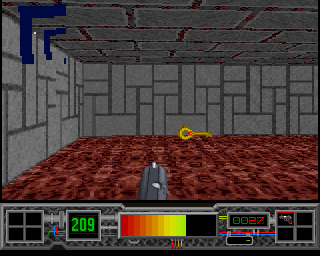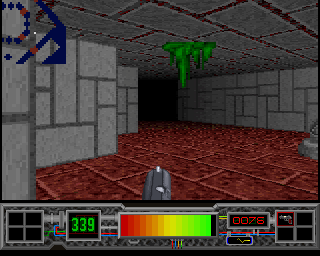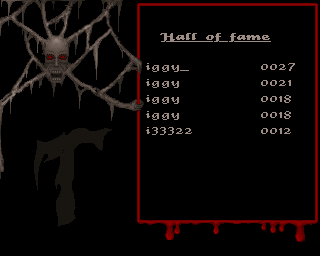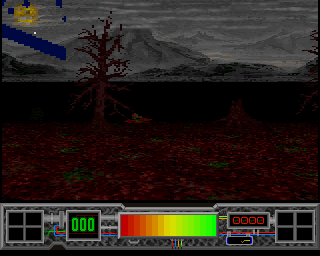Retro Replay Review
Gameplay
Testament thrusts you into the battered boots of a lone soldier stranded in a forsaken realm teeming with ancient horrors. From the moment you awaken outside Ghuwta’s crypt, the game establishes a relentless pace: every corridor, overgrown graveyard, and shadowy dungeon could be your last. Unlike more forgiving shooters, Testament rewards caution and mapping as much as trigger discipline. You’ll find yourself pausing at every corner, listening for the hiss of undead abominations or the creak of shifting stones.
The core loop revolves around exploration, combat, and progression through the collection of scrolls—the titular “testaments.” Each level hides one of these scrolls within its winding pathways, and only once you claim it can you save your game and advance. This mechanic adds a thrilling sense of urgency: die before securing the scroll, and you’re sent back to the start of the level. Hardcore veterans of early first-person shooters will appreciate the challenge; newcomers may find themselves hooked by the tangible relief of that well-earned save point.
Combat in Testament is satisfyingly brutal. Armed with an arsenal reminiscent of classic ’90s shooters—ranging from a standard rifle to arcane weapons that pulse with magical energy—you will blast through skeletal warriors, demonic familiars, and spectral guardians. Enemy behavior is straightforward but effective: they charge in numbers, forcing you to strafe carefully and conserve ammo. Moments of respite allow you to scavenge for health potions and ammo clips, while environmental hazards like crumbling floors and spike traps keep you on your toes.
One standout feature is the inclusion of a map overlay, which provides brief but essential guidance through the labyrinthine levels. Unlike modern auto-mapping, you must reveal the map by exploring, which deepens the sense of immersion and discovery. Testament balances its old-school design with subtle conveniences, ensuring that while you’re challenged, you’re never completely lost in the darkness.
Graphics
Visually, Testament is unapologetically retro, adhering closely to the aesthetic established by Doom and its contemporaries. Pixelated walls, flat bitmapped sprites for monsters, and simple texturing evoke a potent sense of nostalgia for early ’90s first-person shooters. While some players might dismiss this style as dated, fans of pixel art and vintage design will find the presentation both authentic and charming.
The engine delivers a handful of modern embellishments, such as distance-based light fading that lends each outdoor graveyard and cavernous crypt a haunting atmosphere. Even on an unexpanded Amiga 1200, you’ll witness torches flicker along damp corridor walls, and shadows dance across tombstones in the moonlight. Though there’s no looking up or down—your view remains locked horizontally—the clever use of lighting gradients keeps your surroundings from feeling flat.
One of Testament’s most memorable graphical touches is its dynamic portal effects. When you open sealed doors or unleash magical energies, you’re greeted with brief animations that ripple across the screen. These flourishes may be simple, but they highlight the game’s commitment to creating a spooky mood within hardware limitations.
While textures and resolutions are modest by today’s standards, the art direction compensates with thematic consistency. Every level feels distinct—be it a moss-covered mausoleum, a blood-soaked underground crypt, or a labyrinthine dungeon with glowing runes. Testament proves that a cohesive visual style can outweigh polygon counts when it comes to crafting an immersive horror shooter.
Story
At its core, Testament unfolds a minimalist yet compelling tale of survival. You are a soldier on a doomed expedition, separated from your comrades as you delve into the haunted lands ruled by the ancient magus Ghuwta. Rumor has it that Ghuwta’s crypt holds unimaginable power—and a restless spirit determined to ensure none escape his domain. The sparse narrative is delivered through environmental cues: shattered stone tablets, dripping blood trails, and the eerie echoes of Ghuwta’s distant incantations.
Though dialogue and cutscenes are virtually nonexistent, the game’s storytelling thrives on atmosphere. As you collect each piece of the testament scroll, fragments of the magus’s history emerge: a once-mighty sorcerer whose cruelty shook the empire, now eternally bound to his own crypt. These scraps of lore lend weight to your quest, transforming your mission from mere escape into a confrontation with a fallen deity’s fury.
Testament leverages its horror elements to reinforce the narrative, using sudden monster ambushes and disorienting level design to evoke the sense that Ghuwta’s spirit is watching your every move. You feel like an intruder in a cursed realm, and each revelation raises the stakes. The climax—an obligatory showdown with the ghost of Ghuwta—serves as a fitting finale, combining the game’s combat mechanics with its rich supernatural backdrop.
While the story may not rival plot-driven blockbusters or RPG epics, its lean approach is perfectly suited to the game’s pace and style. By focusing on environmental storytelling and player discovery, Testament encourages you to piece together the lore at your own speed, making every scroll found a small triumph in unraveling the magus’s dark legacy.
Overall Experience
Testament is a love letter to the golden age of first-person shooters, tailored for players who relish old-school difficulty, pixel-perfect gunplay, and gothic horror. From the moment you step into its haunted levels, you’ll sense a deliberate design philosophy: challenge over convenience, atmosphere over flash, and exploration over linearity. If you’ve yearned for a game that recalls Doom’s relentless pace but drenches it in medieval dread, Testament delivers admirably.
Performance on the Amiga 1200 is impressively smooth, with no expansions required. Load times are brief, and the frame rate holds steady even in monster-infested arenas. The control scheme is intuitive, albeit limited by the engine’s lack of vertical aiming; however, this constraint becomes part of the game’s identity rather than a flaw. Combined with the map overlay and fading-distance lighting, these technical choices coalesce into a cohesive, haunting experience.
Testament’s audio design further elevates the immersion. Creaking doors, distant wails, and thunderous spell effects punctuate the tension, while a brooding soundtrack of dark synths and choral whispers underscores every encounter. Though the sound palette is relatively minimal, it’s thoughtfully deployed to keep players on edge throughout their escape from Ghuwta’s domain.
In the end, Testament may not revolutionize the genre, but it refines and pays homage to its roots with passion and precision. For Amiga enthusiasts, retro FPS fans, and horror aficionados alike, it offers a compelling blend of challenge, style, and spooky storytelling. If you’re prepared to face Ghuwta’s ghost and survive a night in his cursed empire, Testament is an expedition well worth undertaking.
 Retro Replay Retro Replay gaming reviews, news, emulation, geek stuff and more!
Retro Replay Retro Replay gaming reviews, news, emulation, geek stuff and more!









Reviews
There are no reviews yet.